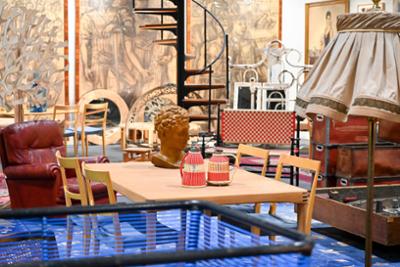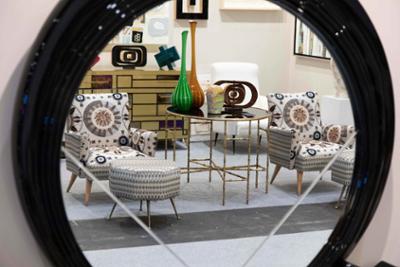

How to decorate combining antique and modern furniture
Learn and play at combining your furniture
Learn how to decorate your home by combining antique and modern furniture and objects and give your personal spaces a strong personality.
Combining antique and modern furniture can create a unique blend of antique charm and contemporary sophistication. Over time, art has conquered all domestic spaces. Designers, artists and architects alike include art and collectibles in their productions in order to bring a more personal, sophisticated and warm design aspect to these spaces.
Nowadays, many collectors and art lovers decorate their homes with original pieces acquired at art fairs, antique and auction shops or galleries, but also with faithful reproductions of the great works of art history. In this way, art leaves the museum spaces to form part of the regular decoration of our homes and reflect our personality, style and character to others, based on that artist or artistic current with which we have deeply connected.
A brief introduction to furniture
The antiques sector is characterised by the fact that antique furniture is one of the most important business volumes in the sector, as these pieces are made with high quality materials using artisan techniques, often lost in the course of time, and with unique ornamental elements. As for its stylistic parameters, these are as extensive as the artistic trends that we find throughout the history of art, fluctuating according to the evolution of taste and fashion of the moment in a direct feedback between the two.
Although the history of furniture is almost as old as civilisation, its history as a collector's item begins mainly with its development in the flamboyant Gothic period of the 15th century, although it was not until the Italian Renaissance that we find an interest in the ornamental and aesthetic aspects of the pieces. Thus, in the international art market we find numerous examples from the 17th century onwards.
In the Spanish market, furniture of English origin enjoys an outstanding success, both in auction houses and at fairs, due to its value for money. There is also a prevailing collector's interest in French Empire style furniture and the styles produced during the reigns of Louis XIII and XIV. Popular Spanish furniture tends to appear more frequently at auctions in the form of small objects, rather than tables, bargueños and cabinets. The latter were used to store and display objects of great value in the home, and were located in reception rooms.
Modern furniture, on the other hand, emerged as a result of the professional development of design using the new avant-garde of the 20th century, and is characterised by a strong link between functionality and design for today's smaller homes and spaces. At the beginning of the last century, the Modern Movement in design and architecture was also known as the International Style, with the participation of such prominent names as Le Corbusier, Charlotte Perriand, Pierre Jeanneret, Lily Reich, Eileen Gray and Charles Mackintosh, among others, whose influence is still present in the current tastes of collectors and in the development of design by contemporary and emerging designers.
The importance of colour
In the same way that we combine our furniture to produce a harmonious sensation around us, we should also have this idea as a basis when choosing colours, as they are the ones that will end up defining the personality of our home. Colour in itself is a scientific construct, but when applied to interior design it becomes a form of non-verbal language that will end up influencing your room and those who visit you.
Although it is true that colours are intimately linked to the tastes of each person, there is a generalised way of thinking in which each colour, depending on its nature, can arouse a different emotion or sensation. For this reason, our choice of colour will be important to make our home the first place we want to be.
First of all, we will have to play with the space and the location of our rooms, using three types of colours: main colours, secondary colours and accent colours. The first type is mainly applied to the walls, ceilings and floors, characterised by being the neutral colours that will end up making up the extra shades of the rest of the room.
Despite the boom of recent years, interior design has been a constant character throughout history because there are a multitude of colours and decorative modalities that have been the hallmark of a historical period or artistic movement. Simply because of changing fashions, these differ from contemporary movements, so when it comes to combining furniture from different chronological periods, we must bear in mind that we will have to harmonise their characteristics with the most current variables: who inhabits that space, the lighting it has and the dimensions it has.
The key is to choose the right space
Selecting the perfect space is a complicated task, but full of possibilities to get the maximum potential out of your home. A perfect example can be through the integration and combination of different patterns and textures, such as tapestries, rugs and curtains to add depth at the same time. Antique furniture and objects that are over 100 years old often contain unique characteristics that allow them to stand out from more standardised objects. The straight lines of modern furniture, on the other hand, contrast perfectly with the unique language of antiques.
A classic piece of furniture can function as the focal point of a given space, supported by modern external elements that can be integrated and establish a harmonious dialogue. Or an antique cabinet can be used as a bar cabinet or as a stand for modern and vintage TVs and stereos. Small pieces of furniture, such as sideboards or armchairs, and decorative objects can also be used to create charming little spaces that convey comfort and warmth.
When placing an antique piece of furniture, especially those with dark wood tones, we must take into account placing them in bright and luminous spaces so that they do not look old-fashioned or overloaded due to the possible lack of light. Similarly, we must balance from textures, styles and materials, if the furniture is made of wood, it may be interesting to combine it with other pieces of other materials such as metal, glass or textiles, both antique and modern.
On the other hand, grouping pieces and objects, such as antique plates or vases, around small collections can help us to ensure that their essence is present in every possible corner of our home. Modern vintage floral motifs, in trend in recent years along with geometric and psychedelic motifs from the 60s and 70s, also allow us an easy, fun and colourful combination that plays perfectly from the retro with the solid and elegant colours common in modern furniture.
In any case, the most important thing is to imbue your spaces with your own style and taste, in a perfect, integrating and original dialogue between different chronologies, between the antique and modern language of your objects.
Daniel Alvarado Santiago y Ada Ji Azuaga Carretero






